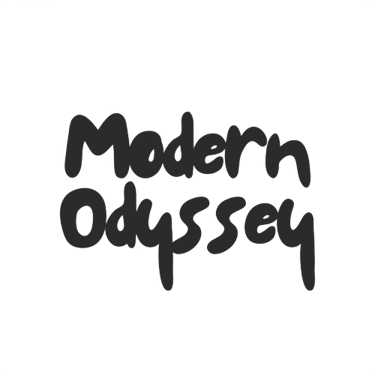2025 August
The Best Things to Do in Luang Prabang: The Timeless Jewel of Laos
(Map Included)
by Evi


Luang Prabang, a UNESCO World Heritage city, is often described as the jewel of Laos. Nestled between the Mekong and Nam Khan rivers and surrounded by misty mountains, it’s a place where time seems to slow down. Once the royal capital of the country, the city is steeped in history and tradition, blending French colonial architecture with golden Buddhist temples and tranquil monasteries. What makes Luang Prabang truly special is its harmonious mix of cultural heritage and natural beauty. Whether you’re wandering through its old quarter, taking part in the serene morning almsgiving (Tak Bat), or exploring nearby waterfalls and caves, every moment feels like stepping into a living postcard.


1. Stroll Through the Old City
The Old Town of Luang Prabang is a postcard-perfect blend of tradition and charm. Narrow streets lined with French colonial villas, Lao wooden houses, and golden temple spires invite you to wander without a plan. You’ll pass palm shaded cafés, local artisans carving intricate woodwork, and monks quietly sweeping temple courtyards. The entire historic center is a UNESCO treasure, so every corner tells a story, whether it’s about the city’s royal past or the fusion of Lao and French architecture. Walking here in the early morning or late afternoon, when the light is soft and the streets are calm, feels like stepping into another era.
2. Heuan Chan Heritage House
For a peek into traditional Lao life, Heuan Chan Heritage House is a must. This beautifully preserved 19th-century teakwood home offers exhibits on local customs, handicrafts, and family traditions. Once belonging to a noble family, it’s now a cultural center where you can learn about weaving, Lao cuisine, and even take part in workshops. The tranquil garden is perfect for sipping a traditional herbal tea while imagining what life was like here before Luang Prabang became a tourist hub.
Opening Hours: 9 AM - 5 PM
3. Royal Palace & National Museum
The Royal Palace, built in 1904 for King Sisavang Vong, blends Lao and French styles in an elegant yet understated way. Today, it houses the National Museum, showcasing royal artifacts, Buddhist art, and gifts from foreign dignitaries. One of the highlights is the Prabang Buddha, a revered 83-centimeter-tall statue after which the city is named. Strolling through the palace’s throne room, filled with shimmering mosaics, gives you a glimpse into the country’s regal past before the monarchy was abolished in 1975.
Opening Hours: 8 AM - 11:30 AM and 1:30 PM - 4 PM Ticket: aprox. 2.50 euro


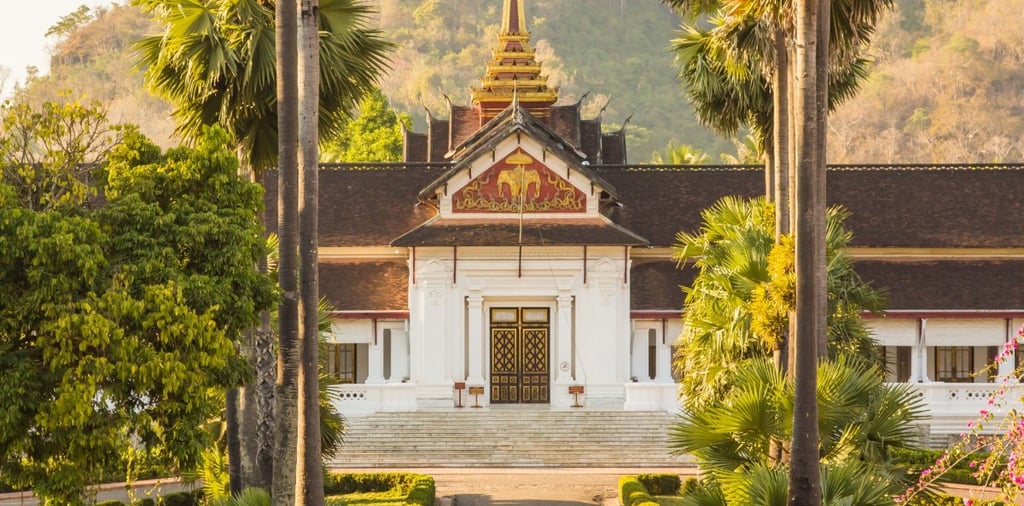

4. Hit the Markets
Markets in Luang Prabang aren’t just for shopping, they’re for soaking up local life.
Luang Prabang Night Market: A lively evening bazaar along Sisavangvong Road where you can pick up handwoven scarves, silver jewelry, and delicious street snacks.
Sayxoumxon Market: A more local experience with fresh produce, spices, and everyday goods.
Phosy Market: The city’s largest market, perfect for seeing the variety of ingredients that make Lao cuisine so unique, think dried riverweed, exotic fruits, and fragrant herbs.
5. Witness Tak Bat
At dawn, the streets of Luang Prabang become a silent procession as hundreds of monks collect alms from locals. This ancient Buddhist ritual, known as Tak Bat, is one of the city’s most spiritual experiences. It’s one of the most sacred daily traditions in Theravada Buddhist culture, symbolizing humility, generosity, and the interdependence between monks and laypeople. Monks live on these offerings for the day, and in return, they offer blessings to the givers. The ceremony begins just after dawn (around 5:30–6:00 AM). Monks in saffron robes walk single file through the old town’s main streets, especially along Sakkaline Road, Kingkitsalat Road and nearby side streets. To witness it respectfully: dress modestly, keep a distance, avoid flash photography, and never block the monks’ path. The ceremony is not a tourist show but a sacred daily tradition, being mindful ensures it remains that way. You can also book a tour in order to be a part of the sacred ritual by offering food and interacting with the monks, like this one from Klook.
6. Climb Phousi Hill
Right in the center of town, Phousi Hill rises 100 meters above Luang Prabang, offering panoramic views of the city, the Mekong River, and the surrounding mountains. The climb is around 300 steps, but along the way, you’ll find small shrines, Buddha images, and viewpoints that invite you to pause. Sunrise and sunset are especially magical here—though be prepared to share the moment with others at sunset.
Entrance Ticket: 30.000 LKP


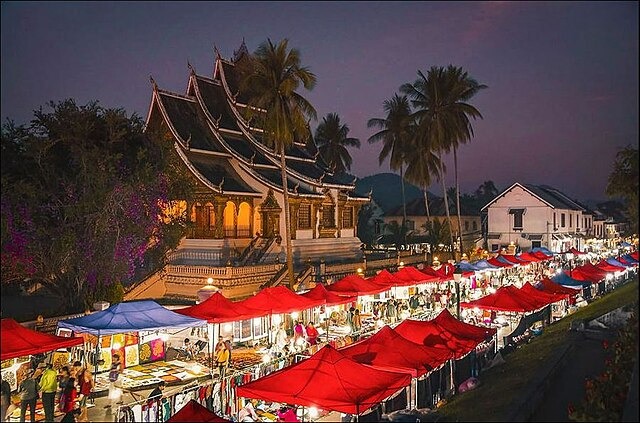

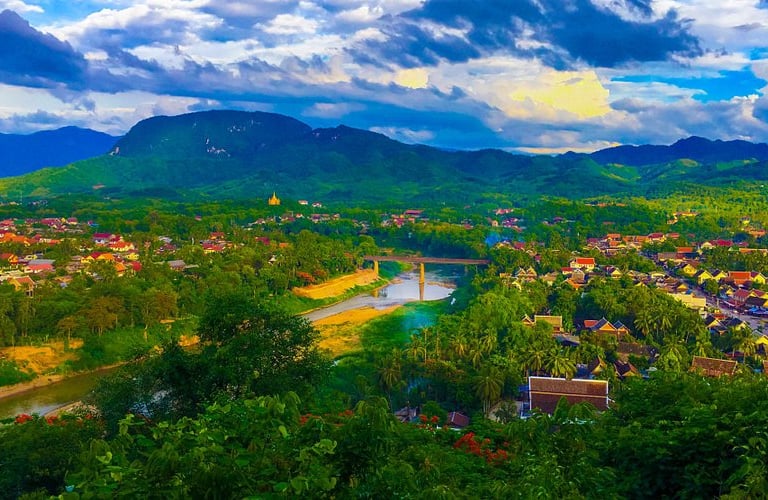

7. Go Temple Hopping
Luang Prabang is home to over 30 temples, but these stand out:
Wat Xiengthong: The crown jewel of Luang Prabang’s temples, built in the 16th century with stunning mosaics and sweeping roofs. Also called the Temple of the Golden City, is one of Luang Prabang’s most iconic and historically important temples, and honestly, it’s the one you absolutely can’t skip.
It was built in 1560 by King Setthathirath and served as a royal temple under the Kingdom of Lan Xang. For centuries, it was not only a spiritual center but also the site of Lao kings’ coronations. It’s a living piece of history that survived multiple wars and even the 19th-century Siamese invasion, when many other temples were destroyed.
What makes Wat Xiengthong special:
Elegant architecture – It’s the textbook example of classic Lao temple design with its low-sweeping, layered roof that nearly touches the ground.
Mosaic of the Tree of Life – On the back wall of the sim (ordination hall), you’ll see a shimmering glass mosaic telling a creation myth, made in 1960 for the temple’s 400th anniversary.
Royal funeral carriage house – A richly decorated building housing a massive gilded funeral chariot used in royal processions, surrounded by intricate wooden carvings.
Small chapels and stupas – Each one has its own story, with Buddha images from different periods and artistic styles.
Located near the confluence of the Mekong and Nam Khan rivers, Wat Xiengthong is also one of the most photogenic spots in Luang Prabang, especially in the golden hour when the light catches its ornate details.
Wat Sibounheuang: A small but beautiful temple known for its peaceful atmosphere. The temple sits quietly near the tip of the peninsula, not far from Wat Xiengthong, and dates back to the 18th century. Unlike the more famous royal temples, Wat Sibounheuang has a more intimate, neighborhood feel, it’s still an active place of worship for local monks and residents, so you might find yourself sharing the courtyard with saffron-robed novices going about their daily routines.
Architecturally, it features a graceful Lao-style roof with layered eaves and delicate gold stenciling on deep red doors and pillars. Inside the sim (ordination hall), you’ll find serene Buddha statues, often draped in saffron cloth, and faded murals that tell stories from the Jataka tales (legends of the Buddha’s previous lives).
Because it’s less visited, Wat Sibounheuang offers a peaceful atmosphere, perfect for sitting quietly, taking in the scent of incense, and enjoying a slower, more contemplative side of Luang Prabang’s spiritual life.
Vat Sensoukharam: (often called Wat Sene for short) is one of Luang Prabang’s most striking temples, both for its beauty and its rich history. Built in 1718 by King Kitsarath, it was the first monastery in Luang Prabang to be constructed entirely with fired clay bricks, a significant leap in durability compared to earlier wooden structures. Its name, Sensoukharam, means "Temple of a Hundred Thousand Treasures", a reference to the wealth and prosperity it was intended to symbolize.
The temple is instantly recognizable thanks to its bright saffron-yellow walls, deep red trim, and elaborate golden stenciling that catches the sunlight. Its sweeping multi-tiered roof, adorned with naga (serpent) motifs, embodies classic Lao architectural style. The sim (ordination hall) houses a large, serene Buddha statue surrounded by smaller figures, while the exterior is decorated with intricate floral and mythological patterns.
Vat Sensoukharam remains a working monastery where monks study and chant daily, so if you visit in the early morning or late afternoon, you may hear the rhythmic sound of Buddhist prayers. Because it’s less crowded than Wat Xiengthong but more ornate than the tiny neighborhood temples, it offers a perfect balance between grandeur and tranquility.
8. Explore Nature
Nature lovers are spoiled for choice:
Kuang Si Waterfall: A multi-tiered turquoise cascade about 29 km from town, perfect for swimming and hiking. You can visit the waterfall and rafting down a 1-kilometer creek in a single package like this one from GetyourGuide or you book just your transfer here. You can combine a visit to the waterfall and the Pak Ou caves by an organized boat and bus tour like this one from GetyourGuide
Tat Sae Waterfalls: Less famous but equally lovely, with limestone pools surrounded by forest.
Pak Ou Caves: Located along the Mekong, these sacred caves house thousands of Buddha statues left by pilgrims over centuries. You can visit the caves by an organized boat tour like this one from GetyourGuide
Take a Guided Mountain Bike Tour like this one from GetyourGuide to soak up the lush natural beauty of the Lao countryside, stop at villages along the way for the chance to immerse yourself in local life.
9. Try Lao Cuisine
Luang Prabang is a food lover’s paradise. Some must-tries include:
Mok Pa: Steamed fish in banana leaves with herbs.
Khao Soi: A noodle soup with a rich, slightly spicy broth.
Luang Prabang sausages: Fragrant with lemongrass and galangal.
Larb: A minced meat salad with herbs, chili, and lime.
Nam Khao (Lao Crispy Rice Salad) is one of Laos’ most beloved and unique dishes, a true must-try when visiting Vientiane or Luang Prabang.
Try these at street stalls, night markets, or family-run restaurants for the most authentic flavors.
10.Try Lao Massage
After a day of exploring temples, climbing Phousi Hill, or wandering the old town, there’s nothing better than unwinding with a traditional Lao massage. In Luang Prabang, you’ll find plenty of spas and massage houses ranging from simple local spots to elegant riverside wellness centers. The style is similar to Thai massage but usually gentler, focusing on pressure points, stretching, and deep relaxation. Many places also offer oil massages, herbal compress treatments, or foot reflexology which is perfect for sore legs after sightseeing. A massage here isn’t just self-care, it’s part of the Luang Prabang experience, slow, peaceful, and deeply restorative.
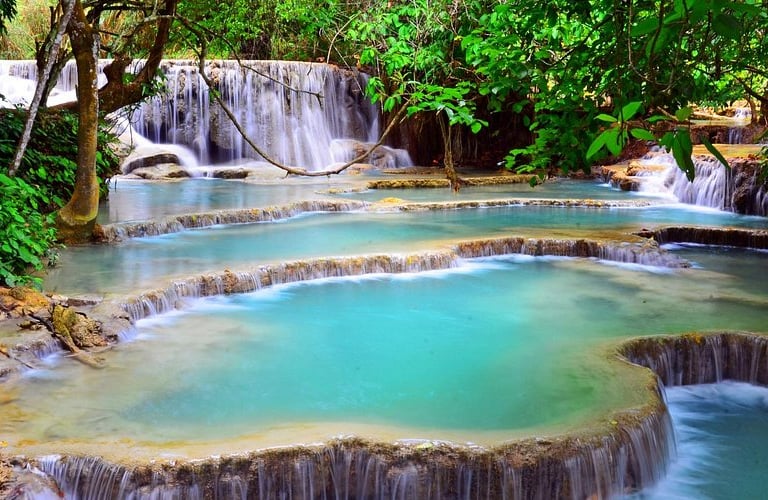





Where to Eat in Luang Prabang.
When it comes to dining in Luang Prabang, the city is full of charming spots where you can experience both traditional Lao flavors and international twists.
Manda de Laos – A refined dining experience beside UNESCO-listed lotus ponds, serving elevated Lao cuisine in a dreamy setting.
The Belle Rive Terrace – Riverside dining with sweeping Mekong River views, perfect for a sunset dinner.
Tamarind – A must-visit for first-timers, known for authentic Lao dishes and cooking classes that introduce you to the country’s flavors.
Café Toui – A cozy, casual spot serving hearty Lao and fusion dishes full of flavor.
Ock Pop Tok Silk Road Kitchen – Combines delicious local food with the story of Lao textiles, all in a beautiful riverside setting.
Nang Tao Bamboo Garden – A hidden gem serving homemade-style Lao meals, perfect if you want to eat like a local.


Where to Stay in Luang Prabang
Luang Prabang offers a wonderful mix of accommodations, from riverside boutique hotels to charming colonial-era guesthouses—so you can tailor your stay to your style and budget. Many are set in restored French villas or traditional Lao wooden homes, blending heritage charm with modern comforts.
Relaxful Hotel – A comfortable option with modern rooms and a laid-back vibe, great for travelers who want simplicity and convenience.
Chic Stay Hana Hotel – Stylish and cozy, perfect for those who love a touch of design and a boutique feel.
Dawn Boutique Hotel – A charming stay that combines comfort with authentic local hospitality, making you feel at home in Luang Prabang.
The Secret Luang Prabang – A beautifully designed boutique property with a tranquil atmosphere, ideal for couples or those seeking a peaceful retreat.
Souphattra Hotel Luang Prabang – A luxury option with elegant rooms, a stunning pool, and refined Lao architecture, offering the perfect mix of tradition and comfort.
If you’re looking for something more traditional, consider a riverside guesthouse with views of the Mekong or Nam Khan rivers, or even a heritage homestay in a restored Lao wooden house for a deeper cultural experience.


How to Get to Luang Prabang
By Air:
Luang Prabang International Airport (LPQ) is just 4 kilometers from the city center and is the most convenient way to arrive, especially if you’re coming from abroad or from other major Southeast Asian hubs. There are direct flights from cities like Bangkok, Hanoi, Chiang Mai, Siem Reap, and Vientiane. The airport is small and efficient, and a taxi or tuk-tuk ride into town usually takes about 15 minutes.
From Vientiane (the capital):
By Plane: A quick 1-hour flight is the fastest option, with multiple daily departures.
By Bus or Minivan: The journey takes around 10–13 hours, depending on the route and season. Overnight buses are available but can be bumpy due to winding mountain roads.
By Train The modern Railway connects Luang Prabang to Vientiane in just 2–3 hours. Trains are air-conditioned, comfortable, and scenic, passing mountains, tunnels, and rural villages. Luang Prabang Station is 15 km from the city center, and Vientiane Station is 20 km from downtown. Tickets require a passport and are best booked in advance. You can reserve a ticket through 12GO


From Thailand (Chiang Rai):
A scenic way to reach Luang Prabang is by taking the Mekong River slow boat from Huay Xai, after a van transfer from Chiang Rai and an easy bus-assisted border crossing. The two-day journey offers breathtaking views of riverside villages and jungle landscapes, with an overnight stop in the charming town of Pakbeng. On the second day, the boat continues downstream, arriving in Luang Prabang by late afternoon, a journey that’s as much an adventure as it is transportation. You can book your trip through GetyourGuide or book your cruise directly from Mekong Cruises that include an overnight hotel stay, visits to Khamu, Hmong, and Lao Loum villages to learn about local life, a visit at the Pak Ou Caves, home to thousands of Buddha statues and traditional Lao meals served onboard.
How to Get Around Luang Prabang
The old town is compact and best explored on foot or by bicycle, most attractions, temples, and markets are within easy walking distance. Many hotels offer free bikes, and rentals are cheap and widely available.
For destinations outside the center, tuk-tuks are the most common transport. You’ll need to negotiate the fare before hopping in. The main ride-hailing apps available are LOCA and InDrive, which are basically Laos’ local version of Grab or Uber. Payment can be made in cash or via card (if you add it to the app).Motorbike rentals are available, but roads can be challenging for beginners, and helmets are essential.
If you’re heading to places like Kuang Si Waterfall or Pak Ou Caves, you can hire a private songthaew (shared truck taxi), join a group tour, or book a driver through your hotel.


Staying Connected in Luang Prabang
Having internet access makes navigation, translation, and booking activities much easier. The easiest option is to get an eSIM before you arrive, using services like Revolut, Airalo or Nomad, which let you connect as soon as you land without visiting a store.
If you prefer a physical SIM card, local providers like Unitel, Lao Telecom, and ETL sell prepaid SIMs at the airport, convenience stores, and phone shops. Expect affordable packages with plenty of data for a week or more.
Most hotels, cafés, and restaurants offer free Wi-Fi, but speeds can vary, so a local SIM or eSIM ensures you stay connected even during day trips into the countryside.


An experience that stays with your heart.
Luang Prabang is the kind of place that lingers in your memory long after you’ve left, a rare blend of history, spirituality, nature, and slow-paced charm. Whether you’re wandering through centuries-old temples, sharing smiles with saffron-robed monks during the morning alms ceremony, cooling off at turquoise waterfalls, or savoring fragrant Lao dishes, every moment feels steeped in authenticity. It’s a city where time seems to move gently, inviting you to pause, breathe, and soak in its quiet magic. Stay a few days, let yourself get lost in its winding streets and golden sunsets, and you’ll quickly understand why Luang Prabang isn’t just a destination, it’s an experience that stays with your heart.
Drop us a comment bellow
Check our other post for Laos
The Best Things to Do in Luang Prabang: The Timeless Jewel of Laos (Map Included)
Nestled between the Mekong and Nam Khan rivers in northern Laos, Luang Prabang is a city where time seems to slow down. Once the royal capital and now a UNESCO World Heritage Site, this enchanting town is famous for its gilded temples, colonial-era architecture, and deeply rooted Buddhist traditions. Over the centuries, it has been influenced by the Khmer, Thai, and French, resulting in a cultural blend that’s both unique and captivating.
Evi
8/16/202512 min read
